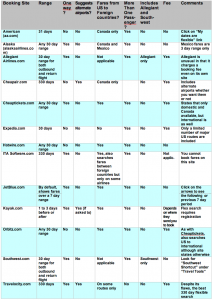With fares going higher, and low fare seats getting scarcer, there is no better time than now to brush up on your flexible date search skills. If you don't particularly care when you fly as long as there's a cheap fare, flexible is the way to go.
To help you, we've put together this nifty chart (we're all about charticles these days, have you noticed?) and some important tips to help you distinguish between the various Web sites offering flex search.
Most sites let you search only over a 30 day period of your choice, both for the outward bound and the return flight (these include Cheaptickets, Hotwire, and Orbitz). Allegiant and Southwest, however, allow you to search over one 30 day period on the outbound and any other on the return. Then there are Travelocity and Cheapair, both of which allow a 330 day search. Only problem is, they're not very good at guaranteeing that there will be seats available at the fares initially shown in the search, whereas the other sites do a better job at this (the reason is that these searches take up a lot of computer processing power, and you can't have it both ways: a long date range search, or better seat availability predictions).
And there are other distinctions between search sites, as the chart below shows. Some do one-way searches, others don't; most allow you to search for more than one seat, Travelocity doesn't; some do searches on routes from the US and Canada to international destinations (even if they say they don't); and others do not. And some charge fees, others give you a free ride (many online travel agencies have suspended booking fees through May 31, 2009).
Alaska Airlines in July (2008) added a nice 30 day search; and American has had a 31 day search for quite a while, as has Southwest. But most airlines are limited in their flexible date searches, which is a shame.






